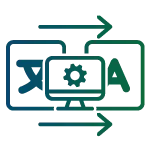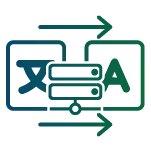
Computer-Assisted Translation Services
Trusted Translations utilizes top tier computer-assisted translation (CAT) tools to supplement, but never to replace, the work of our human translators. Our CAT tools help us improve translation quality and lower costs.

Computer-Assisted Translation Services
Trusted Translations utilizes top tier computer-assisted translation (CAT) tools to supplement, but never to replace, the work of our human translators. Our CAT tools help us improve translation quality and lower costs.
Quality Related Content
Home » Services » Human Translation » Quality » CAT Tools
Enhancing Human Translation with Advanced Tools
Computer-assisted translation (CAT) is a broad and somewhat imprecise term that covers a range of translation tools, from the fairly simply to the most complex. In general, CAT incorporates a manual editing stage along with the use of software, making translation an interactive process between human linguists and their computers.
CAT tools should not be mistaken as general machine translation engines. Instead, CAT harnesses the machine processing power of computers to aid the skill of human translators. Examples of the CAT tools our translators may use include: spell checkers, grammar checkers, terminology managers, electronic dictionaries, terminology databases, translation memories, and formatting preserving tools, among others.
CAT Tools and Translation Memories
A CAT tool saves translation units (TUs) in a translation memory (TM). The translation of each segment— normally a chunk (or string) of words that can be either part of a sentence or a full sentence—is saved together with the source text. This makes translation memories different from terminology tools like glossaries, although they are often used together; glossaries are databases of words like nouns, verbs, adjectives, adverbs, or longer idiomatic expressions that should be translated in a certain way depending on the context.
Translation memories are a database file or set of files, so they need a software interface to be used and modified. This software interface is what is commonly referred to in the industry as a CAT tool, which can be a standalone software program or a web-based application. The CAT tool presents the segments to the linguist in a convenient way that facilitates the ease and speed of the translation process.
CAT tools enable human translators to leverage previously approved quality translations in an environment that allows for quick and easy access to translation memories. CAT tools also provide a means to build on past translation memories or to create new memories through corrections and/or the translation of new segments. This iterative process is key to constantly improving our quality and delivery time.
CAT Tools and Repetitions
How do CAT tools and translation memories work? When a translator applies the translation memory to new content, there are several possible outcomes. One possible outcome is a “No Match,” which simply means that there are no matching segments in the memory. This phrase needs to be translated from scratch by an expert human translator.
A “Full Match” (“100 percent” match) means there is a phrase (or segment) in the new text that is identical to an already translated phrase stored in the translation memory. The translator needs to verify the segment is correctly used within the context of the new translation, and simply approve it if correct.
Finally, a “Fuzzy Match” is a phrase or segment in the new content that is similar, but not identical, to a segment stored in the translation memory. The human translator must then review the results and likely modify them in order to translate the phrase accurately.
A “repetition” is a segment that repeats several times in the document at hand; using a translation memory means the segment/phrase must only be translated once, with its other instances then auto-generated.
As we can see, CAT tools are an excellent way for translators to know how best to apply their expertise to different sections of content.
Trusted Translations uses CAT tools and terminology tools as aids for our human translators, helping improve the overall quality of medium to large translation projects. If you are interested in learning more about the use of CAT tools, contact us today.


